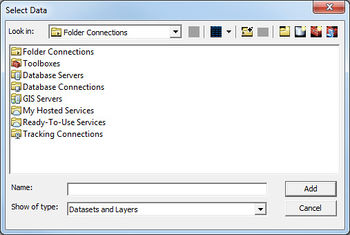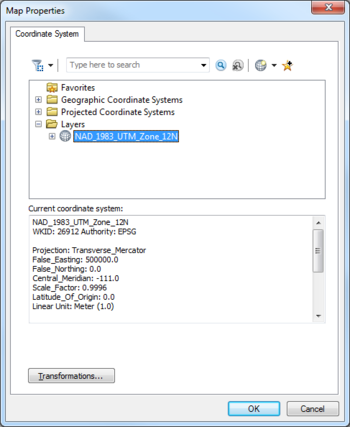SMS:GIS Module Menus
The following menus are available in the the GIS Module:
Standard Menus
See SMS Menus for more information.
Module Specific Menus
Data
Most of the SMS modules have a Data menu, but the items in this menu are different for each module. The GIS Module commands include:
GIS Data Menu Commands
- Enable ArcObjects
ArcObjects® is a development platform provided by ESRI that allows developers of other applications (such as SMS 32-bit) to incorporate ArcView/ArcGIS® capability directly within their application. SMS can use ArcObjects® to access some of the same functionality in SMS that is available in ArcGIS®, providing SMS is running on a computer that has a current license of ArcGIS®.
The Data | Enable ArcObjects command queries the ESRI license manager for ArcView/ArcGIS® to see if a license exists. If a valid license is found then the ArcGIS® functionality within SMS is enabled and access will be allowed. If a license is not found then the ArcGIS® specific features remain unavailable.
- Add Data
SMS uses ArcObjects® to incorporate much of the ArcMap® functionality directly. SMS can open any ArcGIS® supported file (coverages, shapefiles, geodatabases, images, CAD, grids, etc.) and use the ArcGIS® Display Symbology properties to render the GIS data and then display it in SMS.
The Add Data command is only available if ArcObjects® have been enabled. The Add Data command is used to open datasets and layers (*.lyr) files into SMS using ArcGIS®.
When ArcObjects® is enabled, SMS is able to load any of the ESRI supported formats, including shapefiles, coverages, geodatabases, grids, images, CAD files and others, as GIS data layers in SMS. These data can then be converted to feature objects in map coverages.
- Add Shapefile Data
The Add Shapefile Data command is only available if ArcObjects® have NOT been enabled. The Add Shapefile Data command is used to open a Shapefile (*.shp) into SMS.
- Add MIF/MID File Data
SMS uses ArcObjects® to incorporate much of the ArcMap® functionality directly. SMS can open any ArcGIS® supported file (coverages, shapefiles, geodatabases, images, CAD, grids, etc.) and use the ArcGIS® Display Symbology properties to render the GIS data and then display it in SMS.
The Add MIF/MID Data command is used to open a MIF/MID file (*.mif) into SMS using ArcGIS®.
- Attribute Table
SMS uses ArcObjects® to incorporate much of the ArcMap® functionality directly. SMS can open any ArcView® supported file (coverages, shapefiles, geodatabases, images, CAD, grids, etc.) and use the ArcGIS® Display Symbology properties to render the GIS data and then display it in SMS.
The Attribute Table command opens the Attribute Table dialog. The shapefile layer of interest is specified in the Attribute Table dialog. Once the shapefile layer has been specified, the Attributes dialog will be shown. The attributes for each record in the specified layer can be viewed in the Attributes dialog.
- Join Table to Layer File:Join Table.jpgJoin Table Dialog
SMS uses ArcObjects® to incorporate much of the ArcMap® functionality directly. SMS can open any ArcGIS® supported file (coverages, shapefiles, geodatabases, images, CAD, grids, etc.) and use the ArcGIS® Display Symbology properties to render the GIS data and then display it in SMS.
The Attribute Table command opens the Attribute Table dialog. The shapefile layer of interest is specified in the Attribute Table dialog. Once the shapefile layer has been specified, the corresponding DBF Table File (*.dbf) must be selected. The Join Table dialog is then shown.
The Join Table to Layer command, available when right-clicking on a layer in the Project Explorer, allows joining the attributes of one database file (*.dbf) to the features of a GIS layer based on a key attribute field. This is particularly important when the features are stored in a shapefile with a minimal set of attributes, and additional attributes are stored in a separate *.dbf file. The two files are related based on an attribute field named MUID. Other GIS data layers may be similar where the features contain some kind of key indexing field and the attributes are stored in a separate table that can be joined to the features based on the index field values.
After selecting the Join Table to Layer command a prompt will appear for the database file to join using the standard Select File dialog. The Join Table dialog will then appear and ask to select the Join Field from the GIS data layer attributes and the Join Field from the table being joined to the GIS data layer. Often these field names will be the same as in the example below, but they are not required to be the same. The important thing is that they contain similar information from which a join can be made. Finally, select to join all of the attributes from the join table or just add a specific field.
The join does not permanently alter the GIS data layer on the hard drive of the computer.
- Layer Properties
The Layer Properties command opens the Select a layer dialog. The shapefile layer of interest is specified in the Select a layer dialog. Once the shapefile layer has been specified, the Layer Properties dialog is shown. See the ArcGIS® documentation for further explanation of the Layer Properties dialog. The Layer Properties command is only available if ArcObjects® have been enabled.
- Map Properties
The Map Properties dialog is used when ArcObjects® is enabled to specify the coordinate system to display/map features from the ArcGIS® data layer. An ArcGIS® data layer should have a currently defined coordinate system associated with it. If the coordinate system is geographic (latitude/longitude), then ArcObjects® is able to "guess" correctly at the projection. Using the coordinate system as defined in the Map Properties, specify the coordinate system to use to display features/rasters. While this does not change the actual geometry of the layer, it will display in the main graphics window according to this projection and any data mapped to coverages will be mapped into the coordinate system specified by the Map Properties.
GIS layers can have an associated global projection. If a layer has an associated projection, the entities will be automatically displayed in the current project projection. GIS projection information can come from multiple sources:
- Files – ESRI shapefiles can have an associated *.prj file that contains the projection information. MapInfo MIF/MID files contain projection within the MIF file.
- Assigned in SMS – assigns a projection to a layer by right-clicking on the layer and choosing Coordinate Conversions. When doing this, SMS will save a PRJ file or a new set of MIF/MID files with the updated information.
The WMS article WMS:Map Properties has more information about this dialog.
Selection
The GIS Module Selection menu commands are only available if ArcObjects® have been enabled. The GIS Module Selection menu commands include:
GIS Selection Menu Commands
| Command | ArcObjects® Required | Description |
|---|---|---|
| Select by Attributes | Yes | Opens the ArcObjects® Query Wizard Dialog. See the ESRI ArcGIS documentation for further explanation of the Query Wizard dialog. |
| Select by Location | Yes | Opens the ArcObjects® Select By Location Dialog. See the ESRI ArcGIS documentation for further explanation of the Select By Location dialog. |
| Clear Selected Features | Yes | Clears the current selection |
| Interactive Selection Method | Yes | Change the ArcObjects® selection options in use. Options include:
|
| Selectable Layers | Yes | Opens the ArcObjects® Check Selectable Layers dialog. The layers to be selected can be specified. |
Mapping
The GIS Module Selection menu commands are only available if ArcObjects® have been enabled. The GIS Module Selection menu commands include:
GIS Mapping Menu Commands
| Command | ArcObjects® Required | Description |
|---|---|---|
| Arc Objects → Feature Objects | Yes | Opens the GIS to Feature Objects Wizard |
| Shapes → Feature Objects | No | Opens the GIS to Feature Objects Wizard |
| Feature Objects → Geodatabase | Yes | Saves the Feature Objects as a Personal Geodatabase file (*.mdb) |
| Polygons → TIN | No | Converts polygon data to TIN data that will appear in the scatter module. |
GIS Module Right-Click Commands
The following right-click commands are available for GIS objects when ArcObjects are not enabled:
- Remove – deletes the GIS object from the project.
- Transparency – brings up the Layer Transparency dialog.
- Zoom to Extents – frames and centers in the graphics window the extents of the GIS layer.
- Open Containing Folder
- Projection – brings up the Object Projection dialog.
- Register Image – brings up the Register Image dialog.
- Export – resamples and saves the image.
- Export World File – exports data as a world file that includes image registration data.
- Interpolate To – a sub-menu for commands to interpolate the GIS object into one of the following"
- 2D Mesh
- 2D Scatter (both as regular scatter set and as land use data for ADCIRC nodal attributes)
- 2D Grid
- UGrid
- Active coverage
- Convert To – a sub-menu with commands to convert GIS objects.
- 2D Scatter
- 2D Grid
- Feature Contours (contour(s) of the data in the DEM)
- Feature Contours at Given Elevation
- Resampled Raster – creates a new DEM covering the bounds of the selected DEM with a specified spacing.
- Smoothed Raster – smooths the values on the DEM based on use specified weighting functions.
- Trimmed Raster – trims to the bounding box of a coverage or selected polygons.
- Merged Raster – appears when multiple rasters are selected. It creates a new raster that covers all selected rasters with a resolution set to the smallest cell size of any of the selected rasters.
See the article GIS Conversion and Editing for more information.
- Editing – a sub-menu with the following commands:
- Arc Elevation Profile – brings up the Profile Elevations plot for a selected arc.
- Convert to TUFLOW Rainfall Boundary Conditions
If the format is correct, the GIS data can be converted into TUFLOW rainfall boundary polygons on a TUFLOW 1D/2D BCs and Links coverage. For more information, see TUFLOW Boundary Conditions.
Related Topics
SMS Menu Bars | |
|---|---|
| Standard Menus: | File • Edit • Display • Window • Help |
| Module Menus: | 2D Mesh • Cartesian Grid • Curvilinear Grid • GIS • Map • Particle • Quadtree • Raster • Scatter |
| Model Menus: | ADCIRC • BOUSS-2D • CGWAVE • CMS-Flow • CMS-Wave • FESWMS • Generic Model • GenCade • PTM • RMA2 • RMA4 • SRH-2D • STWAVE • TUFLOW |
SMS – Surface-water Modeling System | ||
|---|---|---|
| Modules: | 1D Grid • Cartesian Grid • Curvilinear Grid • GIS • Map • Mesh • Particle • Quadtree • Raster • Scatter • UGrid |  |
| General Models: | 3D Structure • FVCOM • Generic • PTM | |
| Coastal Models: | ADCIRC • BOUSS-2D • CGWAVE • CMS-Flow • CMS-Wave • GenCade • STWAVE • WAM | |
| Riverine/Estuarine Models: | AdH • HEC-RAS • HYDRO AS-2D • RMA2 • RMA4 • SRH-2D • TUFLOW • TUFLOW FV | |
| Aquaveo • SMS Tutorials • SMS Workflows | ||

